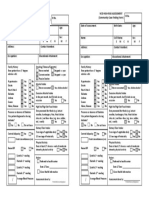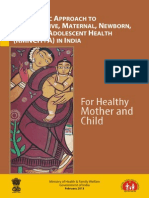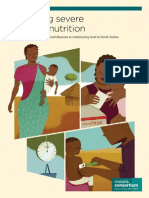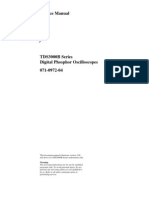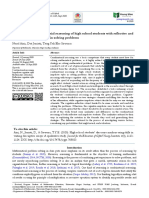0 ratings0% found this document useful (0 votes)
109 viewsUnit: 2
The Primary Health Care Revitalization Division aims to strengthen primary health care in Nepal by expanding coverage of basic health services, promoting social health protection, and addressing issues in urban and environmental health as well as non-communicable diseases. Some of the key challenges they face include demographic changes, integrating vertical programs, addressing inequities, and decentralizing planning to the local level. The division's goals are to provide free basic health services to all citizens, ensure easy access to quality health care, and achieve health-related UN Millennium Development Goals.
Uploaded by
Shristi BakhunchheCopyright
© © All Rights Reserved
Available Formats
Download as PDF, TXT or read online on Scribd
0 ratings0% found this document useful (0 votes)
109 viewsUnit: 2
The Primary Health Care Revitalization Division aims to strengthen primary health care in Nepal by expanding coverage of basic health services, promoting social health protection, and addressing issues in urban and environmental health as well as non-communicable diseases. Some of the key challenges they face include demographic changes, integrating vertical programs, addressing inequities, and decentralizing planning to the local level. The division's goals are to provide free basic health services to all citizens, ensure easy access to quality health care, and achieve health-related UN Millennium Development Goals.
Uploaded by
Shristi BakhunchheCopyright
© © All Rights Reserved
Available Formats
Download as PDF, TXT or read online on Scribd
You are on page 1/ 11
Unit: 2
2.6 Primary Health Care
Revitalization in Nepal:
Introduction:
• As a signatory of Alma Ata declaration of 1978,
Government of Nepal(GON) has fully realized
the importance of continued adherence to
primary health care for the development of
coordinated quality health care services for
people.
• Primary Health Care Revitalization Division
(PHCRD) functions for expanding the coverage
of primary health services in an equitable
manner particularly by addressing the needs of
disadvantaged and unreached population
• In 2009, Ministry of Health and Population
(MoHP) constituted Primary Health Care
Revitalization Division (PRD), a new division,
under the Department of Health Services
(DoHS).
• PHCRD division will assume the mantle to
revitalize PHC in Nepal by addressing emerging
health challenges in close collaboration with the
other DoHS divisions and different supporting
actors.
• The division will make inroads into translating
the constitutionally stipulated fundamental right
of basic free health care into practice by
addressing the disparities in health service
• PHCRD strives to strengthen the gate keeping
functions at the lower level of public health facilities
while enhancing the capacity of District Health
Offices and Municipalities to develop local health
systems that are responsive and accountable to
clients’ needs.
• As mandated by the Constitution of Nepal, the
division plays an instrumental role in expanding the
reach of basic health services at across the
country, particularly focusing on urban areas while
also introducing service packages that are focused
on prevention of NCDs.
• The division also facilitates continuum of care
across preventive, promotive, curative and
rehabilitative components of health services.
• Components and function of PHCRD
Components:
1. National Free Health: Expand outreach
services, free basic health services; community
health units
2. Social Health Protection: Promote good
governance in health through social audit
3. Urban and Environmental Health: Expand and
strengthen primary care to people living in urban
areas in collaboration with local governments and
municipalities
4. Non-communicable Diseases(NCD): Pilot and
expand PEN (Package and Mental Health) package
for NCD focusing on cardio vascular diseases,
cancer, diabetes, chronic obstructive pulmonary
diseases and mental health
Functions:
• Health education was being through a section
in DoHS, which was converted into National
Health Education, Information and
Communication Centre with an objective to
raise health awareness of the people.
• This centre has developed audio visual aids,
media program, calendars with health message
to prevent communicable disease, water borne
disease and promotion of health behavior.
Goal of PHCRD:
• Despite much progress revealed by many
countries in implementing PHC through their
health systems, the following are some
challenge that need to be addressed if we are
to achieve health goals in general and health
MDG in particular.
1. Misinterpretations of the concept of Primary
Health Care
2. Burden of diseases
3. Inequality in health
4. Escalating health care cost
5. Trade agreements
6. Interdependence of the world
7. Inadequate performance of low efficiency of
the health system
8. Need for more research
9. Financing the health system
10. Need for integrated services
11. Public-Private partnership
12. Climate change
Objectives of PHCRD
• To provide free basic health service to all
citizens as stated in the law.
• To ensure easy access of health services.
• To provide quality health services.
• To provide health services to urban poor,
vulnerable and marginalized, and for people
with disability.
• To achieve the health sector MDGs by making
the delivery of free health care services
effective.
• To develop future program and strategies
commensurate with regular monitoring and
evaluation of free health care services.
• To implement health insurance.
• To implement program ensuring citizens right to
clean environment.
• To mobilize community participation for
cooperation at local level.
Issues, challenges and actions
The health issues and challenges that lie ahead in
putting the PHC approach and principles on ground
are as follows:
• Demographic changes and epidemiological
transition
• Public private partnership
• Integration vertical program and improving quality
of care
• Tackling issues in equity in health through
addressing social determinants of health
• sector wide approaches
• Local level planning and decentralization way
You might also like
- Family Focused Nursing Care 1st Edition by Sharon A. Denham-Test BankNo ratings yetFamily Focused Nursing Care 1st Edition by Sharon A. Denham-Test Bank19 pages
- Operation & Installation Manual For Wave Pool100% (3)Operation & Installation Manual For Wave Pool98 pages
- NCD High-Risk Assessment (Community Case Finding Form) NCD High-Risk Assessment (Community Case Finding Form)No ratings yetNCD High-Risk Assessment (Community Case Finding Form) NCD High-Risk Assessment (Community Case Finding Form)1 page
- BSN 4th Sem Ethics Fresh KmuINS Slides By Nursing TutorNo ratings yetBSN 4th Sem Ethics Fresh KmuINS Slides By Nursing Tutor136 pages
- Kel 7 Standarized Nursing Languages BasicsNo ratings yetKel 7 Standarized Nursing Languages Basics16 pages
- A Strategic Approach To Reproductive, Maternal, Newborn, Child and Adolescent Health (RMNCH+A) in India100% (3)A Strategic Approach To Reproductive, Maternal, Newborn, Child and Adolescent Health (RMNCH+A) in India81 pages
- Unit 5 Medical Social Workers in Hospital SettingsNo ratings yetUnit 5 Medical Social Workers in Hospital Settings12 pages
- Topic 2 Concept of Public Health and Community Health NursingNo ratings yetTopic 2 Concept of Public Health and Community Health Nursing11 pages
- Health Education and Community Organizing Are Necessary in Providing Community Health ServicesNo ratings yetHealth Education and Community Organizing Are Necessary in Providing Community Health Services9 pages
- Public Health Nursing Community Health Nursing100% (1)Public Health Nursing Community Health Nursing23 pages
- Effectiveness of Planned Teaching Programme On Prevention of GastroenteritisNo ratings yetEffectiveness of Planned Teaching Programme On Prevention of Gastroenteritis16 pages
- Chapter Two: Health Determinants, Measurements, and TrendsNo ratings yetChapter Two: Health Determinants, Measurements, and Trends65 pages
- GLOBAL HEALTH TRENDS JUNE 13th 2024 2NDNo ratings yetGLOBAL HEALTH TRENDS JUNE 13th 2024 2ND30 pages
- Community Medicine Journal Club Guide and Topics List 2022 09 23No ratings yetCommunity Medicine Journal Club Guide and Topics List 2022 09 236 pages
- X. Records in Family Health Nursing PracticeNo ratings yetX. Records in Family Health Nursing Practice4 pages
- Aksum University-Department of Nursing For 3 Yr BSC Nursing StudentsNo ratings yetAksum University-Department of Nursing For 3 Yr BSC Nursing Students21 pages
- Integrating Severe Acute Malnutrition Into The Management of Childhood Diseases at Community Level in South Sudan100% (1)Integrating Severe Acute Malnutrition Into The Management of Childhood Diseases at Community Level in South Sudan36 pages
- National Health Programmes: Dr. M.L. SiddarajuNo ratings yetNational Health Programmes: Dr. M.L. Siddaraju40 pages
- Community Health Nursing Process (The Basics of Community Health Nursing by Gesmundo)100% (1)Community Health Nursing Process (The Basics of Community Health Nursing by Gesmundo)18 pages
- What Is Copar?: COPAR Stands For Community Organizing Participatory Action ResearchNo ratings yetWhat Is Copar?: COPAR Stands For Community Organizing Participatory Action Research4 pages
- Acinetobacter Baumannii Skin and Soft-Tissue: Infection Associated With War TraumaNo ratings yetAcinetobacter Baumannii Skin and Soft-Tissue: Infection Associated With War Trauma6 pages
- Western Civilization 9th Edition Jackson J. Spielvogel - Read the ebook online or download it as you prefer100% (1)Western Civilization 9th Edition Jackson J. Spielvogel - Read the ebook online or download it as you prefer52 pages
- Weibull Analysis Guide & Case Study - Pardus ConsultingNo ratings yetWeibull Analysis Guide & Case Study - Pardus Consulting16 pages
- Cell Line Profile: ECACC Catalogue No. 84113001No ratings yetCell Line Profile: ECACC Catalogue No. 841130012 pages
- African Daisy Orange: Dimorpotheca Greek Dis (Twice) + Morphe (Shape) + Theka (A Fruit)No ratings yetAfrican Daisy Orange: Dimorpotheca Greek Dis (Twice) + Morphe (Shape) + Theka (A Fruit)11 pages
- Mental Models: An Interdisciplinary Synthesis of Theory and MethodsNo ratings yetMental Models: An Interdisciplinary Synthesis of Theory and Methods13 pages
- Physical Education and Health 12: 3 Quarter Week 3No ratings yetPhysical Education and Health 12: 3 Quarter Week 36 pages
- Family Focused Nursing Care 1st Edition by Sharon A. Denham-Test BankFamily Focused Nursing Care 1st Edition by Sharon A. Denham-Test Bank
- NCD High-Risk Assessment (Community Case Finding Form) NCD High-Risk Assessment (Community Case Finding Form)NCD High-Risk Assessment (Community Case Finding Form) NCD High-Risk Assessment (Community Case Finding Form)
- BSN 4th Sem Ethics Fresh KmuINS Slides By Nursing TutorBSN 4th Sem Ethics Fresh KmuINS Slides By Nursing Tutor
- A Strategic Approach To Reproductive, Maternal, Newborn, Child and Adolescent Health (RMNCH+A) in IndiaA Strategic Approach To Reproductive, Maternal, Newborn, Child and Adolescent Health (RMNCH+A) in India
- Unit 5 Medical Social Workers in Hospital SettingsUnit 5 Medical Social Workers in Hospital Settings
- Topic 2 Concept of Public Health and Community Health NursingTopic 2 Concept of Public Health and Community Health Nursing
- Health Education and Community Organizing Are Necessary in Providing Community Health ServicesHealth Education and Community Organizing Are Necessary in Providing Community Health Services
- Effectiveness of Planned Teaching Programme On Prevention of GastroenteritisEffectiveness of Planned Teaching Programme On Prevention of Gastroenteritis
- Chapter Two: Health Determinants, Measurements, and TrendsChapter Two: Health Determinants, Measurements, and Trends
- Community Medicine Journal Club Guide and Topics List 2022 09 23Community Medicine Journal Club Guide and Topics List 2022 09 23
- Aksum University-Department of Nursing For 3 Yr BSC Nursing StudentsAksum University-Department of Nursing For 3 Yr BSC Nursing Students
- Integrating Severe Acute Malnutrition Into The Management of Childhood Diseases at Community Level in South SudanIntegrating Severe Acute Malnutrition Into The Management of Childhood Diseases at Community Level in South Sudan
- Community Health Nursing Process (The Basics of Community Health Nursing by Gesmundo)Community Health Nursing Process (The Basics of Community Health Nursing by Gesmundo)
- What Is Copar?: COPAR Stands For Community Organizing Participatory Action ResearchWhat Is Copar?: COPAR Stands For Community Organizing Participatory Action Research
- Exam Prep for:: Public Health Nursing PasscodeFrom EverandExam Prep for:: Public Health Nursing Passcode
- Acinetobacter Baumannii Skin and Soft-Tissue: Infection Associated With War TraumaAcinetobacter Baumannii Skin and Soft-Tissue: Infection Associated With War Trauma
- Western Civilization 9th Edition Jackson J. Spielvogel - Read the ebook online or download it as you preferWestern Civilization 9th Edition Jackson J. Spielvogel - Read the ebook online or download it as you prefer
- Weibull Analysis Guide & Case Study - Pardus ConsultingWeibull Analysis Guide & Case Study - Pardus Consulting
- African Daisy Orange: Dimorpotheca Greek Dis (Twice) + Morphe (Shape) + Theka (A Fruit)African Daisy Orange: Dimorpotheca Greek Dis (Twice) + Morphe (Shape) + Theka (A Fruit)
- Mental Models: An Interdisciplinary Synthesis of Theory and MethodsMental Models: An Interdisciplinary Synthesis of Theory and Methods
- Physical Education and Health 12: 3 Quarter Week 3Physical Education and Health 12: 3 Quarter Week 3


